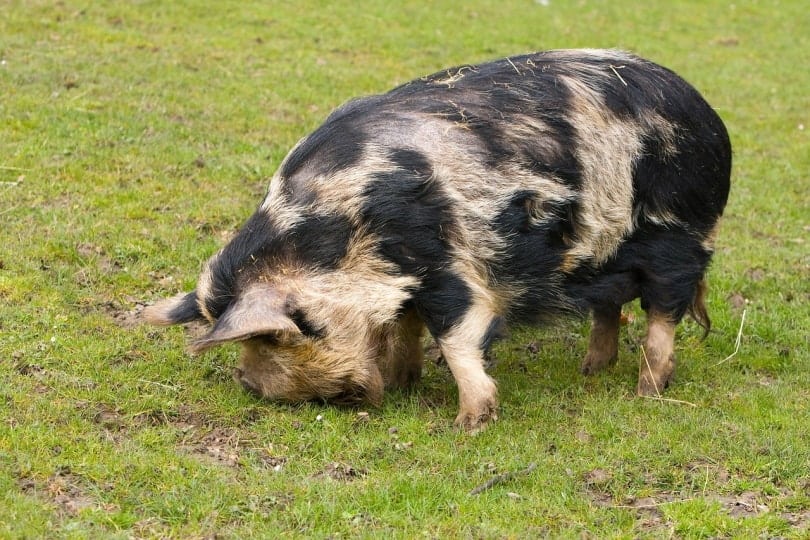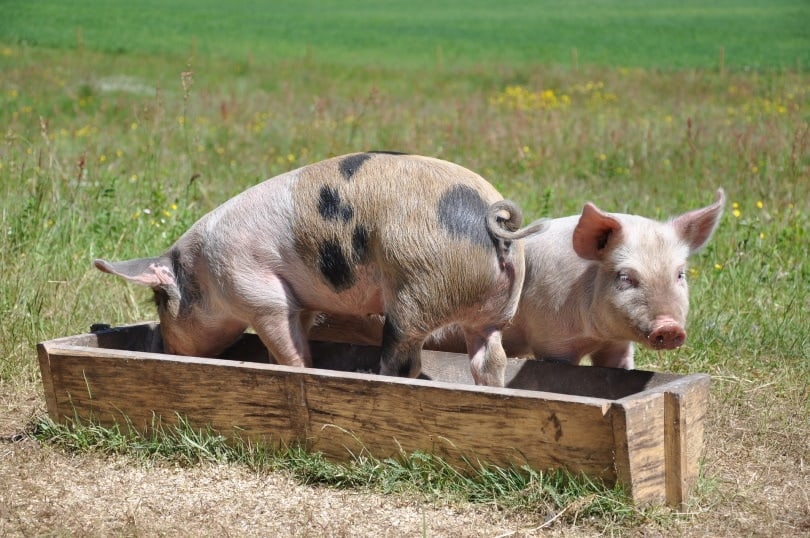Pigs belong to the genus Sus and family Suidae, which consists of many pig species, including the domestic pig species that we know and love and wild boars. There are few pigs left in the wild, as most are domesticated. Even the remaining wild pigs are mostly feral pigs that have escaped domestication. Pigs are experts in surviving in many different environments, and this is partly due to their omnivorous diet.
In the wild and captivity, pigs feed on both plant and animal matter and will eat almost anything that comes their way, making them primarily omnivorous animals. That said, pigs in captivity need a balanced and healthy diet that consists of a wide range of vitamins and minerals.
Let’s take a deeper look at why pigs are considered omnivorous animals.

Pigs Are Omnivorous

Pigs feed on a wide range of foods, including plants, insects, worms, and even small animals. However, while pigs are mostly herbivorous and only 3–5% of their diet consists of meat and insects, the inclusion of these foods in their diet is what makes them omnivores.
Pigs can eat and digest just about anything. They have sharp canines and incisors to help them tear through meat and molars and premolars to help them crunch up plants and vegetables. While pigs will eat whatever comes their way, they are well aware of their dietary needs in the wild. In captivity, since they cannot choose for themselves, pigs need to be fed a balanced and nutritious diet.
Like humans, pigs have a monogastric digestive system, so they can eat various foods infrequently, unlike cows or deer with multiple stomach chambers that require them to eat almost constantly.
Wild pig diet
The diet of wild pigs is highly varied depending on their species and what’s available in their environment. Wild pigs will feed on anything from seasonal fruits and berries to leaves, bark, and eggs, along with small animals like birds, snakes, rodents, and frogs.
Pigs have an excellent sense of smell, and they rely on this to find food rather than their eyesight, which is fairly poor. A pig’s nose is a powerful tool, with a strong disk of cartilage on the end that makes it ideal for digging. Pigs dig their powerful snouts into the soil to find roots, bulbs, bark, insects, and worms.
Typically, a feral pig’s diet consists of 80–90% plant matter, depending on their environment and species, with live animals making up the rest.
Domestic pig diet
Pigs can eat all manner of scraps, from bread and fruit to vegetables and grains. Most domestic pigs are fed on corn-based feeds because these are high in digestible carbohydrates, low in fiber, and fortified with protein supplements, but ideally, they’ll need supplementation of other foods too. Pigs can also be fed on soybean meals, hay, and various vegetables, especially root vegetables.
Due to the risk of diseases that can be transmitted through meat, domestic pigs are not usually fed meat and would need a protein supplement instead. Their protein intake must also increase as they grow, so they are often given whey as their protein source.
Related Read: How to Keep a Pig Entertained? 10 Things They Like to Play With

Foods to avoid giving pigs

While pigs are omnivorous and can eat almost anything, there are certain foods that should be strictly avoided. These include:
- Raw or rotten meat
- Raw eggs
- Unripe tomatoes
- Raw potatoes
- Parsnips
- Celery and celery root
- Onions
- Avocados
- Rhubarb
- Food high in salt
- Sugar

Final Thoughts
Pigs are mostly herbivorous animals, as 90% or more of their diet consists of plants, vegetables, and fruits, but since they do eat insects, worms, and small animals if given the chance, pigs are technically classified as omnivores. Even though pigs are capable of digesting a wide range of foods, including meat, they still need a healthy, balanced diet to thrive, and there are certain foods that should be avoided.
Related article:
Featured Image Credit by: acceptphoto, Shutterstock
